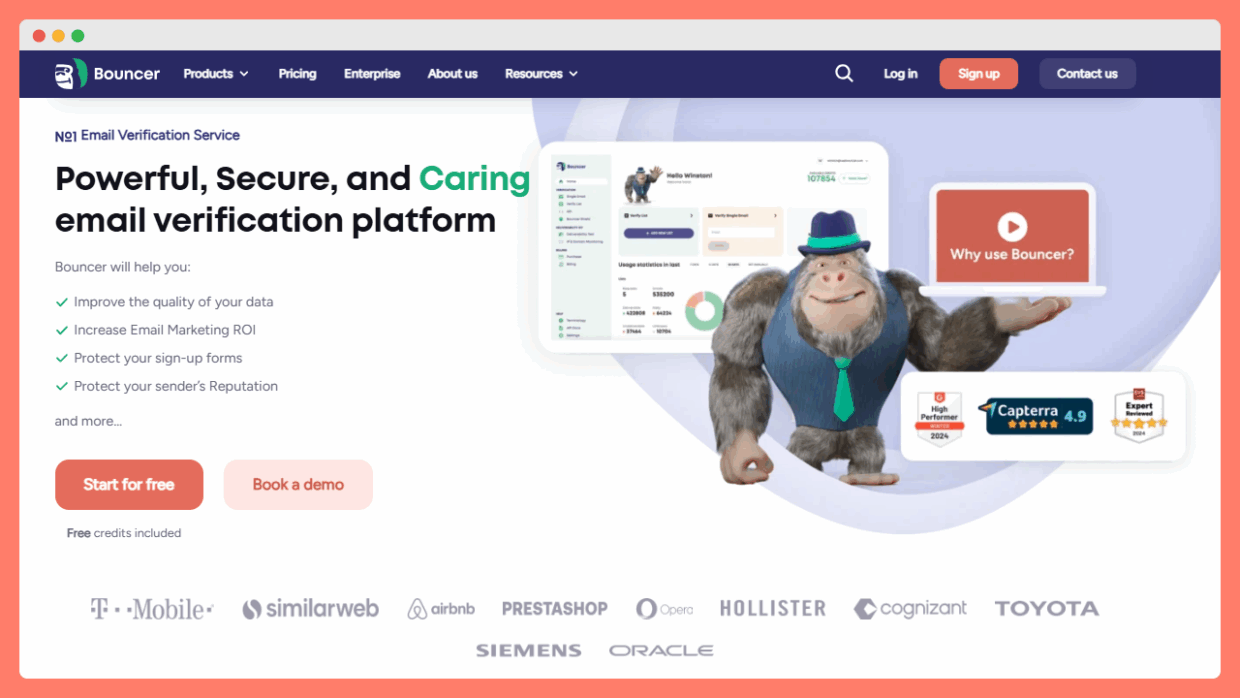Poor list hygiene drags down engagement and puts you at risk for spam traps and complaints.
Your customer relationship management (CRM) data is the foundation of your deliverability.
In this article, I will explain how bad data sneaks into your CRM, how it hurts your inbox placement, and what you can do about it. I will also touch on legal considerations and highlight tools that help keep your lists healthy.
TLDR: summary
- Bad CRM data (typos, duplicates, outdated contacts) hurts deliverability and reputation.
- High bounce and complaint rates signal mailbox providers to filter or block your emails.
- Regular list cleaning, validation, and segmentation improve engagement and inbox placement.
- Follow GDPR and similar laws: collect consent, record it properly, and delete old or inactive data.
- Use tools like Bouncer to verify addresses, block fake sign-ups, detect spam traps, and enrich CRM data.
- Healthy data leads to lower bounces, higher engagement, and stronger sender reputation.
How bad CRM data happens and why it matters
Bad data comes from many places.
- Manual entry mistakes and missing or outdated fields create inaccurate contact records.
- Integrations can create duplicates if one person appears in several lists.
- Over time, addresses go stale as people change jobs or abandon mailboxes.
Unmanaged, these decayed records become spam traps: addresses that look valid but are monitored by filtering organisations to catch irresponsible senders.
When you send to invalid or abandoned addresses, your hard bounce rate climbs, and high bounce rates are among the negative signals that drive down domain reputation.
Poor segmentation is another silent killer. If your CRM lacks complete or consistent fields, you may send irrelevant messages, leading to unsubscribes or spam complaints.
Mailbox providers track engagement and complaints closely – a handful of complaints can hurt your standing with filters.

Routine hygiene processes and their impact
The first step toward cleaner data is defining “inactive.”
You might choose contacts who have not opened or clicked anything for six months. Before purging them, run a re‑engagement campaign asking if they still want your emails. Remove those who remain dormant. This pruning helps lift your overall open and click rates, which ISPs interpret as positive engagement.
Address validation is vital. Check new sign‑ups at entry and run periodic sweeps on existing lists. Validation services weed out invalid, disposable or risky addresses so they never enter your send queue, keeping hard bounce rates low.
Merge duplicates and standardise data formats so that personalisation works and you don’t accidentally send two slightly different messages to the same person. Regular cleansing and verification support better segmentation, reduced bounces and fewer complaints, which all feed into a stronger domain reputation.
Compliance and legal dimensions of data storage and use
Different regions set different rules for handling personal data.
Under Europe’s General Data Protection Regulation (GDPR), you need a lawful basis for storing and processing each contact’s details. Consent must be recorded with a clear audit trail, and individuals can request deletion at any time. Keeping contacts without valid consent not only hurts compliance but also clutters your CRM with inactive or risky records.
In the United States, data privacy laws are more fragmented. The CAN-SPAM Act regulates commercial email and requires clear identification, a valid postal address, and an easy opt-out mechanism.
Some states go further: the California Consumer Privacy Act (CCPA) grants residents rights to access, delete, and opt out of data sales, while similar laws in Colorado and Virginia follow the same spirit.
In Canada, the CASL (Canada’s Anti-Spam Legislation) demands explicit or implied consent before sending marketing emails. It’s one of the strictest anti-spam frameworks, with heavy penalties for non-compliance.
Elsewhere, countries like Australia (Spam Act 2003) and Singapore (PDPA) have their own consent and unsubscribe requirements.
Across all these frameworks, the best practice remains the same:
- collect consent transparently,
- store proof,
- and respect withdrawal requests.
Double opt-in helps verify interest and reduce fake sign-ups. Data processing agreements with CRM vendors or email providers clarify who’s responsible for safeguarding data.
While the details vary by country, the principle is universal: clean, lawful, and respectful data practices protect both your reputation and deliverability.
Tools, workflows & technologies to protect sender reputation
Maintain separate suppression lists for addresses that bounce, unsubscribe or complain.
Suppressing bad addresses stops repeated sending to them. Tools can automate deduplication, periodic validation and monitoring of key metrics. Valimail’s domain reputation guide notes that senders should watch spam complaints (keep them below 0.1 %), monitor bounce rates and avoid spam traps.
Sudden spikes in volume or complaints are warning signs.
Badsender recommends using diagnostic tools, such as Talos or Barracuda, to see if your domain or IP is blocked and to prepare a warm‑up plan for any new sending domains or IPs.
You can also integrate address‑validation services at the point of entry (sign‑up forms), during imports, and in automated routines that check lists regularly.
Bouncer: improving data quality before you hit send
Bouncer is an email verification platform that helps keep your contact lists clean and safe.

Its main application lets you upload a list and check each address for validity, deliverability and risk.
- You can connect it via API to validate addresses in real time.
- Bouncer Shield protects your sign‑up forms by blocking fake or malicious addresses as soon as a visitor types them.
- The Toxicity Check scores addresses on a scale from 0 to 5, highlighting those linked to spam traps or litigation.
- Bouncer’s Deliverability Kit tests inbox placement and checks authentication, while Data Enrichment module adds publicly available company information to enrich your CRM.
- Email Engagement Insights show recent activity: last open, click or reply, so you can segment by engagement.
The platform is hosted in the EU, compliant with GDPR, and has near‑perfect uptime. Using a tool like Bouncer as part of your data‑quality workflow reduces bounce rates and protects your sending reputation.
You can now get started completely for free with 100 credits.
Measuring impact and benchmarking
You need benchmarks to judge whether your hygiene efforts work.
Watch your hard bounce rate, soft bounce rate, spam complaint rate and engagement metrics (opens, clicks, replies) over time.
Valimail suggests keeping spam complaints below one per thousand messages and monitoring bounce rates closely.
Also track conversions or downstream actions (sales, sign‑ups, replies) because high deliverability without meaningful engagement still signals a problem with targeting.
Compare cleaned segments against untreated segments: send the same campaign to a smaller, cleaned list and to a full list, and see which performs better.
Over time, cleaned lists should show higher engagement and fewer negative signals.
Numbers that matter from Bouncer’s Email List Hygiene Report
Before wrapping up, let’s look at what the data says.
Our Email List Hygiene Report combines insights from over 250 survey responses, 12 email experts, and 50 pages of analysis – the first of its kind from Bouncer.
The findings highlight how common poor data hygiene still is, and why keeping your CRM clean directly shapes deliverability results.
Check out the full report: Email List Hygiene Report
📉 Data decay & deliverability problems
- 36% of marketers said their biggest issue is managing bounce rates and spam complaints.
- 29.2% noticed a drop in deliverability over the last six months, while only 14.6% saw improvement.
- Abandoned or invalid emails continue to be a major cause of poor sender reputation.
🧹 List cleaning habits
- 6.7% don’t clean their lists at all.
- 39.5% only remove inactive subscribers occasionally.
- 52% segment their lists – nearly half still send the same message to everyone.
- Bounce rate benchmarks:
0-2%: excellent hygiene
2-5%: acceptable
5-10%: needs review
10%+: serious hygiene issue
🔐 Compliance & authentication gaps
- 42.7% of respondents don’t use SPF, DKIM, or DMARC to authenticate their emails.
- 41.5% monitor their sender reputation monthly, while 10.7% don’t monitor it at all.
- Poor authentication or monitoring increases the risk of spam filtering and domain blacklisting.
📊 Engagement & reputation impact
- Average open rate: 20-30%
- Average click-through rate: 10-20%
- 62.2% have never been blacklisted – a sign that regular cleaning and verification work.
- 70% of businesses have never consulted deliverability experts, even when struggling with inbox placement.
Conclusion
Bad data undermines even the best‑written email.
Invalid addresses, duplicates, and outdated fields inflate bounce and complaint rates, which damages your sender reputation.
Unchecked data can violate privacy laws and waste budget.
You can fix this by auditing your CRM, validating and cleaning your lists regularly, merging duplicates, recording consent properly and removing contacts that are inactive or no longer legally permissible.
Use tools like Bouncer to verify and enrich your data before you send. Monitor key metrics such as bounce rates and engagement to measure progress.
Investing in data quality and CRM hygiene pays off quickly: you spend less while reaching more of the right people and building a healthier sender reputation.


